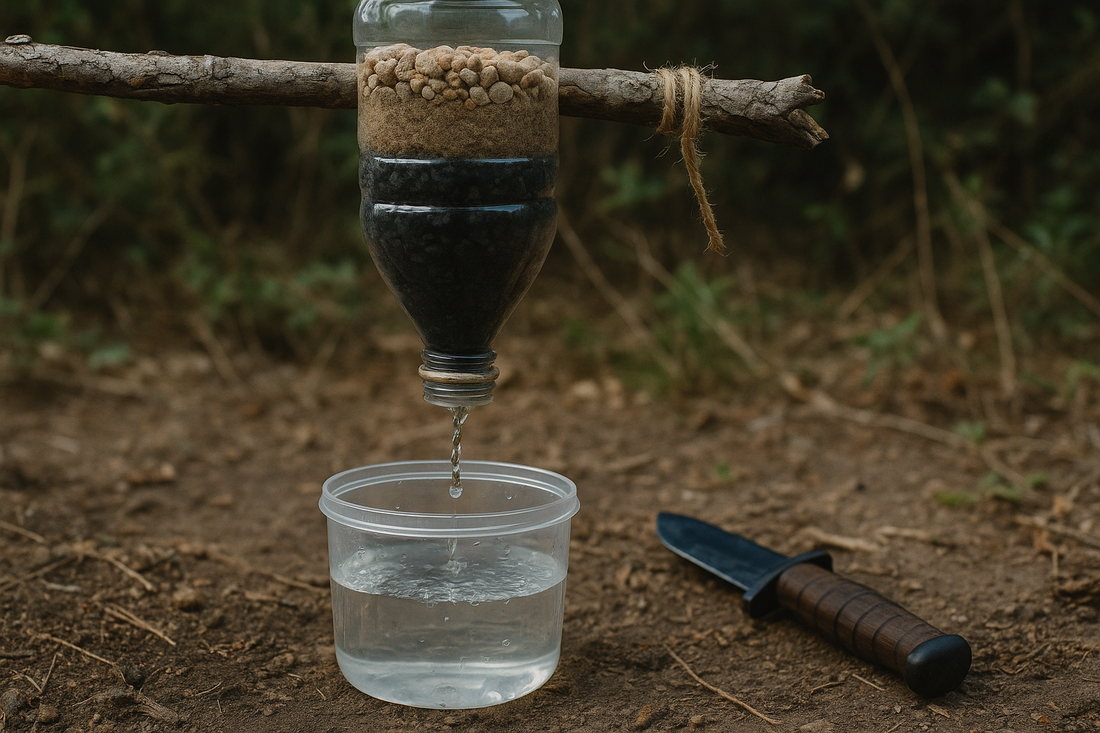
Water Filtration & Purification in Survival: Essential Insights
Summary
In a survival scenario, prioritizing water can be the difference between life and death—without it, dehydration can set in within days. Effective water treatment uses a hierarchy of approaches: clear and boil water first, then filter, add chemical disinfectants, and as a last resort, use solar disinfection. Layering methods ensures safety across physical, microbial, and chemical threats.
Key Concepts
-
Rule of Three & Immediate Access
-
You can survive only about three days without water. Pre-positioning potable water, like a 16–24 oz bottle in your kit, helps bridge the gap before purification systems take effect firestormpreppercoffee.com.
-
-
Treatment Hierarchy: Multiple Lines of Defense
-
Follow this order: Clear & Boil → Filter → Chemical → Solar Disinfection. Each step adds a layer of protection—filtering removes sediments and microbes, boiling kills pathogens, chemicals address residual microbes, and solar disinfection works in a pinch firestormpreppercoffee.com.
-
-
Physical Filtration: Types & Purposes
-
Straws & bottles (e.g., LifeStraw) utilize hollow-fiber microfiltration (~0.2 µm), removing bacteria and protozoa but not viruses or chemicals.
-
Pump & inline filters (Sawyer, Katadyn, HydroBlu) handle larger volumes; ceramic models remove bacteria/ cysts but not chemicals without supplemental treatment.
-
Gravity filters offer hands-free processing, ideal for bug-out setups. Combining filter types can enhance versatility.
-
-
Chemical Disinfection
-
Chlorine dioxide or iodine tablets neutralize bacteria, viruses, and protozoa after filtration firestormpreppercoffee.com.
-
Use them in cold or turbid water for longer dwell times (30–60 min), following manufacturer instructions.
-
-
Boiling & Thermal Methods
-
Bring water to a rolling boil for at least 1 minute (3 minutes above 6,562 ft elevation). Boiling kills pathogens, but does not eliminate chemical pollutants firestormpreppercoffee.com.
-
-
Solar Disinfection (SODIS)
-
Fill clear PET bottles, oxygenate by shaking, seal, and leave in sunlight 6–24 hours; UV radiation and heat deactivate microbes. Effective only in clear water—pre-filtering improves success firestormpreppercoffee.com.
-
-
Homemade Filters
-
A layered filter of gravel → sand → charcoal → cloth can remove sediment and improve clarity, but does not guarantee pathogen removal. Always follow up with boiling or chemicals.
-
-
Advanced Portable Systems
-
Options like LifeSaver bottles use nanoscale filters (15 nm), removing viruses, bacteria, and cysts—providing high-grade purification without chemicals or heat.
-
-
Integrated Approach
-
Best practice combines methods: filter → boil/chemically treat → store. Using multiple layers ensures you address sediment, microbiological, and chemical threats comprehensively .
-
Deep Dive
-
Why multiple methods?
-
No single method handles all contaminants. Sediments block boiling and UV light. Filters may not eliminate viruses. Chemicals leave no residual effect. Integrating methods covers all bases.
-
-
Choosing equipment
-
Straw filters (e.g., LifeStraw) are ultra-portable with limited volume.
-
Pump/inline filters offer higher output but require cartridges.
-
Nano-filter devices like LifeSaver bottles remove even viruses—but are more complex and costly.
-
Gravity filters are ideal for group settings.
-
-
Maintenance & Lifespan
-
Clean and backflush filters as directed; expect cartridge replacement depending on source water quality.
-
Replace chlorine tablet supply periodically; UV filters require battery power and lamp replacement.
-
-
Field improvisation
-
When gear isn’t available, homemade filters can clear turbidity, then boil or chemically treat.
-
Use plant xylem or cloth pre-filters to improve water clarity before follow-up treatment.
-
-
Long-Term Storage
-
Store purified water in clean, sealed containers. Boiled or chemically disinfected water lacks a residual disinfectant, so safeguard stored water from recontamination.
-
-
Liability Disclaimer
Educational Use Only: The techniques, drills, and scenarios presented here are offered “as-is” for informational purposes. Wilderness travel, emergency response, and survival training carry inherent risks—including severe injury or death. By reading, viewing, or implementing any material from this site, you accept full responsibility for your actions and agree that the author bears no liability whatsoever for any loss, harm, or legal consequences that may result. Always seek qualified instruction, obey local laws, and exercise prudent judgment.
Conclusion
In survival scenarios, water treatment requires a multi-tiered approach to handle the full range of hazards. Incorporate physical filtration (straws, pumps, nano-bottles), heat or chemical disinfection, and backup methods like solar disinfection. Regular maintenance, redundancy, and combining methods ensures readiness and true safety.

